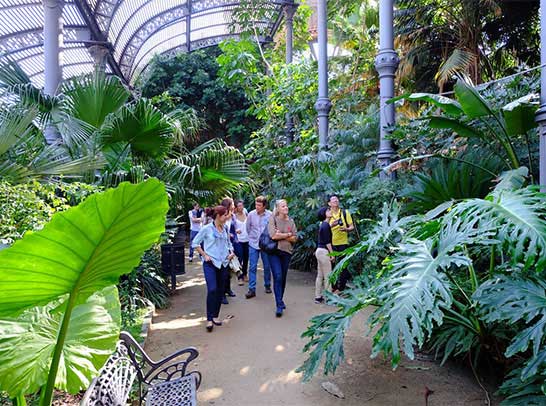
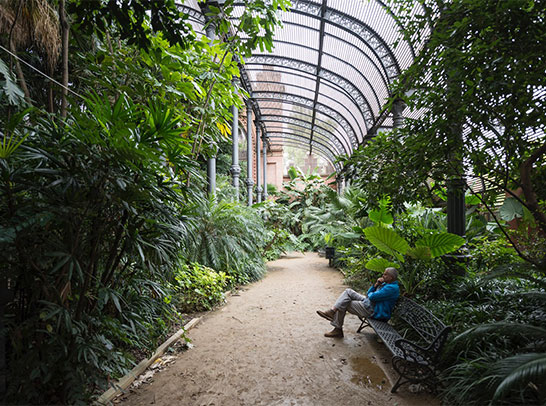
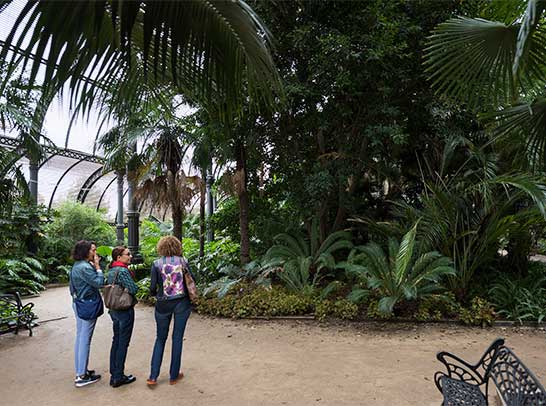
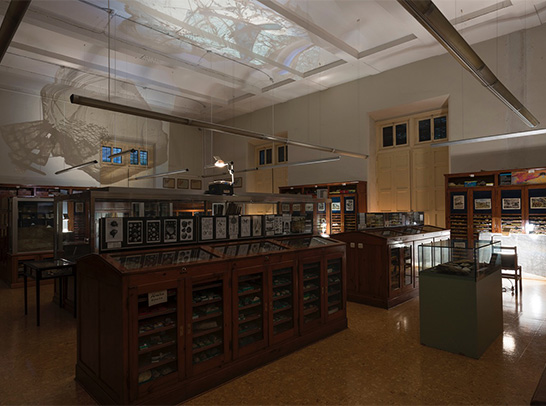
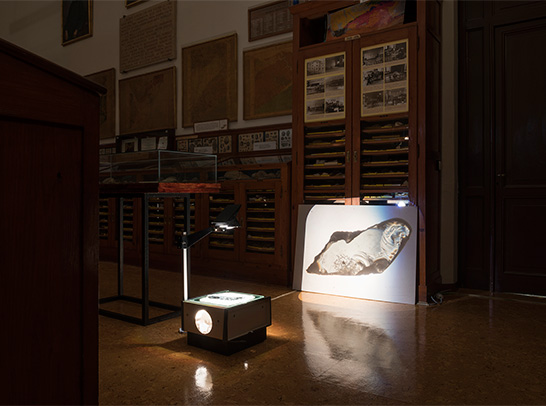
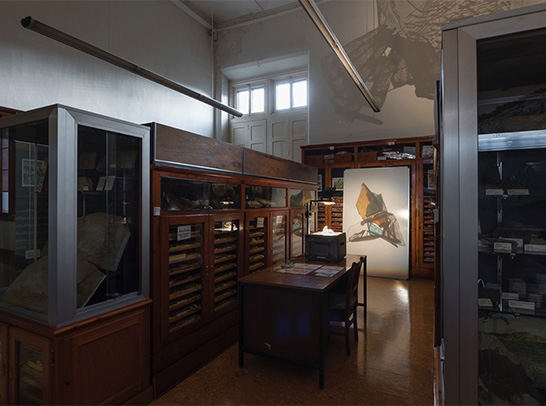
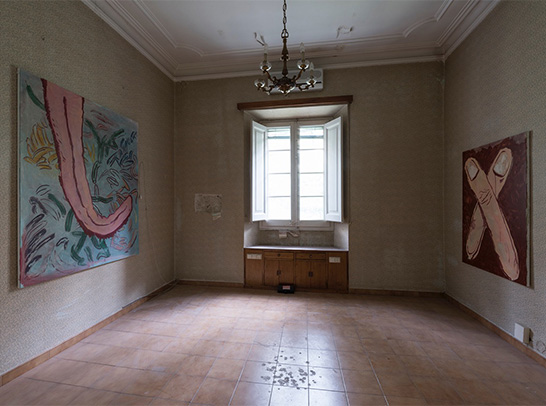
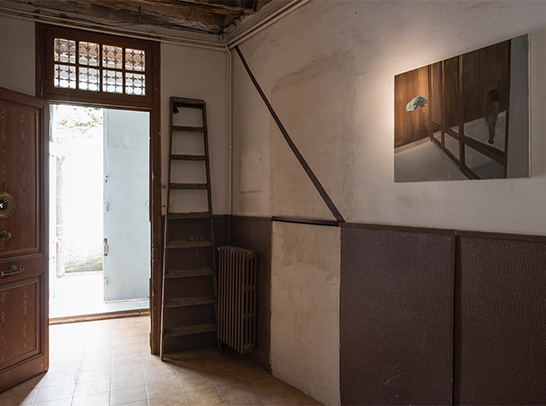
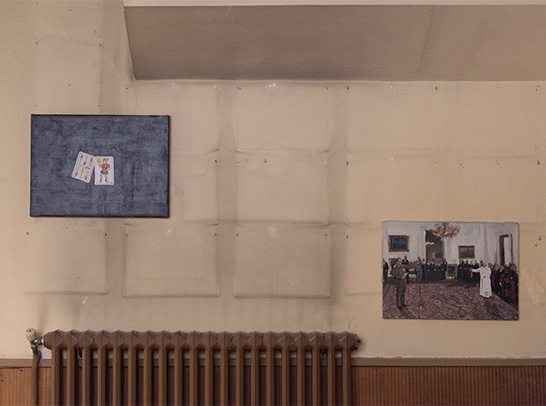
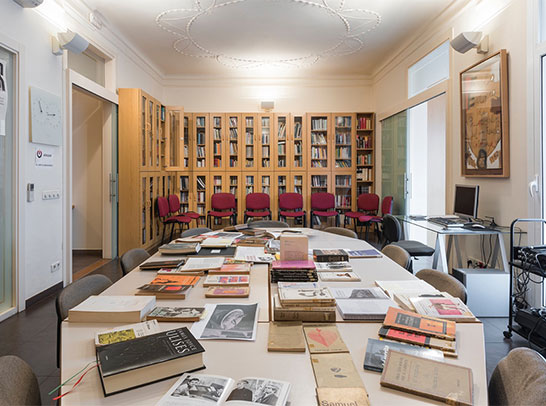
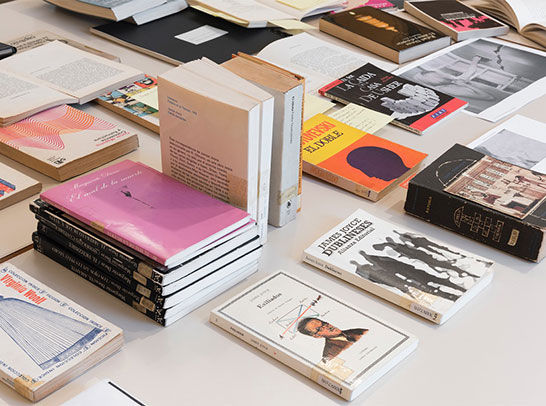
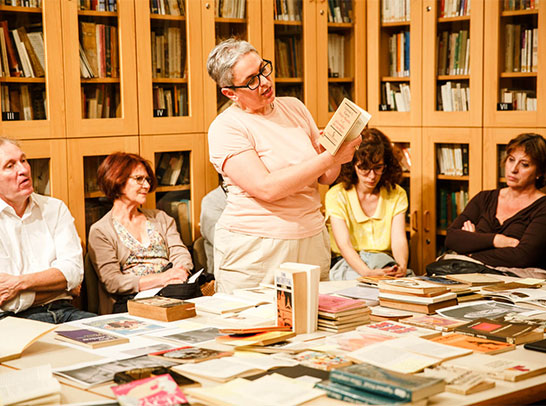
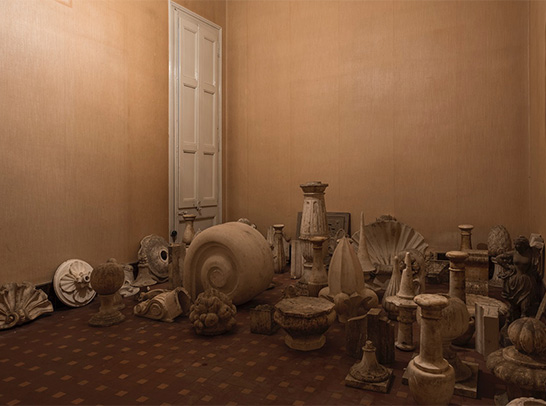
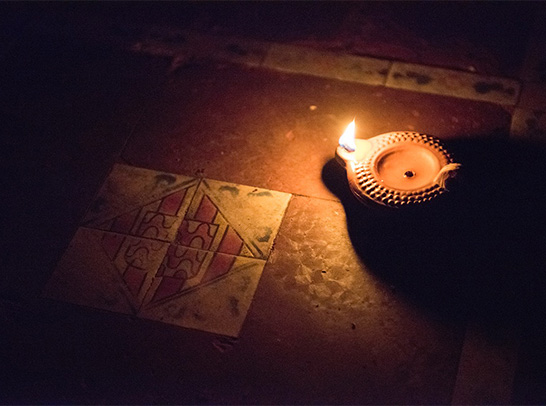
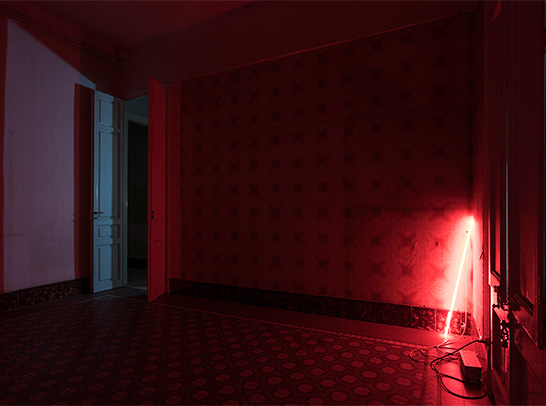
Commissions by: David Bestué (at the former Cosme Toda factory, L’Hospitalet); Dora García (at the Barcelona Freudian Field Library); Jordi Mitjà (at the Geological Museum of the Barcelona Seminary); Pere Llobera & Rasmus Nilausen (at the priest’s house, gardens of La Central bookstore, Raval); and Daniel Steegmann Mangrané (at the Umbracle [Shade house], Ciutadella park).
Latitudes conceived and established ‘Compositions’, five city-wide site-responsive commissions conceived for the first Barcelona Gallery Weekend. The projects complimented the exhibitions and events programmed in galleries and museums by presenting new projects by artists active in the Barcelona art scene. ‘Compositions’ responded to singular locations – civic and private sites significant for their architecture, activity or their history.
‘Compositions’ unfolded at different speeds and rhythms, as one-off events outside the usual contemporary art circuit – including a private psychoanalytic library, a former ceramics factory and a botanical collection. Pinpointing some lesser-known aspects of the city’s cultural history and municipal life, ‘Compositions’ offered moments of interruption, intimacy and immersion throughout the weekend.
Details of each of the projects:
Latitudes conceived and established ‘Compositions’, five city-wide site-responsive commissions conceived for the first Barcelona Gallery Weekend. The projects complimented the exhibitions and events programmed in galleries and museums by presenting new projects by artists active in the Barcelona art scene. ‘Compositions’ responded to singular locations – civic and private sites significant for their architecture, activity or their history.
‘Compositions’ unfolded at different speeds and rhythms, as one-off events outside the usual contemporary art circuit – including a private psychoanalytic library, a former ceramics factory and a botanical collection. Pinpointing some lesser-known aspects of the city’s cultural history and municipal life, ‘Compositions’ offered moments of interruption, intimacy and immersion throughout the weekend.
Details of each of the projects:
↪ David Bestué
Former Cosme Toda factory, L’Hospitalet
Describing the central pillars of David Bestué’s art as being formed by architecture and historiography is perfectly plausible, yet would sound too grandiose given the generous irreverence of his work. In any case, as the artist would undoubtedly ask, what kind of pillars would we be dealing with exactly? Would they be Romanesque columns or steel beams that were holding up his conceptual edifice? Bestué is primarily a sculptor who is fascinated by architecture – not with its hubristic icons or celebrity heroism, but by the very normality with which architectonic tropes underpin an emotional understanding of form.
Bestué’s composite sculptures, photographs and publications form a historiography inasmuch as they have often dealt with the evolution of materials and building techniques in a seemingly diagrammatic or didactic way. Yet Bestué’s experiments with mass, equilibrium, gravity, or the physical language of construction (whether referring to Prehistoric rock tombs or public space in post-Olympic Barcelona) always engage us at a human scale and frequently work through heuristics, frivolity, mockery and farce.
For ‘Composiciones’ David Bestué produced a new installation in the form of a sculptural timeline defined by ignition and invention, fat and oil, obsolescence, fluorescence, luminescence and incandescence – a history of humanity from antiquity to the present day told through the evolution and refinement of lighting technology. Unfolding throughout 15 rooms in the domestic setting of the former Director’s house within the 1920s Cosme Toda ceramics factory, the installation was companioned by sculptural clusters recuperating Art Nouveau ceramics and plaster pieces found in the factory itself. These linked to Bestué's ongoing interest in the evolution of architectural practice alongside building materials and engineering techniques.
2 october, 19:30h: Guided visit of the intervention by David Bestué and Latitudes. c/ Enric Prat de la Riba, 60. L’Hospitalet de Llobregat.
With thanks to Ajuntament de L’Hospitalet, Tomás Langarita, Pau Magrané, Albert Mercadé, Eduard Solanas, Jaume Roig, Federico Vélez.
Bestué’s composite sculptures, photographs and publications form a historiography inasmuch as they have often dealt with the evolution of materials and building techniques in a seemingly diagrammatic or didactic way. Yet Bestué’s experiments with mass, equilibrium, gravity, or the physical language of construction (whether referring to Prehistoric rock tombs or public space in post-Olympic Barcelona) always engage us at a human scale and frequently work through heuristics, frivolity, mockery and farce.
For ‘Composiciones’ David Bestué produced a new installation in the form of a sculptural timeline defined by ignition and invention, fat and oil, obsolescence, fluorescence, luminescence and incandescence – a history of humanity from antiquity to the present day told through the evolution and refinement of lighting technology. Unfolding throughout 15 rooms in the domestic setting of the former Director’s house within the 1920s Cosme Toda ceramics factory, the installation was companioned by sculptural clusters recuperating Art Nouveau ceramics and plaster pieces found in the factory itself. These linked to Bestué's ongoing interest in the evolution of architectural practice alongside building materials and engineering techniques.
2 october, 19:30h: Guided visit of the intervention by David Bestué and Latitudes. c/ Enric Prat de la Riba, 60. L’Hospitalet de Llobregat.
With thanks to Ajuntament de L’Hospitalet, Tomás Langarita, Pau Magrané, Albert Mercadé, Eduard Solanas, Jaume Roig, Federico Vélez.
↪ Dora García
Barcelona Freudian Field Library
Dora García’s contribution consisted in pointing out the wealth of information and the activities programmed by the Freudian Field Library, founded in 1977 by the Argentinian art and literary critic, occasional artist, author and psychoanalyst Oscar Masotta (1930-1979) upon his arrival to Barcelona, having fled Argentina's dictatorship and after a brief stint in London.
The work of French psychoanalyst and psychiatrist Jacques Lacan (1901-1981), reached Spain not from across the Pyrenees, but from overseas: indeed, it was Masotta who introduced Lacanian thought to the Spanish-speaking world. The relevance of Masotta in "a psychoanalytic branch of Conceptualism" (in the words of art historian Juli Carson) only now seem to be fulfilling its true potential. Masotta founded the library together with his fellow citizen Germán García, and their work has been continued since by the Comunidad de Catalunya de la Escuela Lacaniana del Psicoanálisis del Campo Freudiano (ELP), the Catalan Community of the Lacanian School of Psychoanalysis.
One of the outstanding aspects of the library is its significant holdings of literary fiction which is not unusual given the interest of psychoanalysis (since its creation by Austrian physician and founder of psychoanalysis Sigmund Freud, 1856-1939) in literature, as well as the relevance of art and literature in Lacanian thought. Lacan's Seminar XXIII 'Le Sinthome' (1975), for example, refers to the Irish novelist James Joyce (1882-1941).
Dora García's intervention considers the site as a knot which ties together art, psychoanalysis and literature. García selected works of fiction from the library shelves and three conversations activated the space over three consecutive days. The first talk, a ‘solo’ by García, focussed on the library’s holdings of literary fiction. The second, involved several psychoanalysts who discussed the founding of the library and its ongoing role in Barcelona, and the final event was a talk around the work of James Joyce and Jacques Lacan.
The events were live-streamed on Periscope.
With thanks to the Biblioteca del Campo Freudiano de Barcelona, Miquel Bassols, Enric Berenguer, Patrick Bohan, Nora Catelli, Xavier Esqué, Norberto Ferrer, Montserrat Rodríguez, Estela Paskvan.
1 october, 7pm:
Talk by Dora García on the library holdings of literary fiction. Welcome by Emilio Faire and introduction by Mariana Cánepa Luna. All the events at: Avinguda Diagonal 333, 3º 1ª
Video Audio
2 october, 7pm:
Conversation moderated by Dora García with Montserrat Rodríguez, Estela Paskvan, Nora Catelli, Enric Berenguer, Miquel Bassols and Norberto Ferrer, on the origins of the Biblioteca del Campo Freudiano de Barcelona, its founder Óscar Masotta and the Barcelona of 1977. Introduced by Lidia Ramírez.
Video Audio
3 october, 10am:
Conversation between Dora García, Xavier Esqué and Patrick Bohan around James Joyce and Jacques Lacan. Introduced by Rosa Godínez.
Video Audio
The work of French psychoanalyst and psychiatrist Jacques Lacan (1901-1981), reached Spain not from across the Pyrenees, but from overseas: indeed, it was Masotta who introduced Lacanian thought to the Spanish-speaking world. The relevance of Masotta in "a psychoanalytic branch of Conceptualism" (in the words of art historian Juli Carson) only now seem to be fulfilling its true potential. Masotta founded the library together with his fellow citizen Germán García, and their work has been continued since by the Comunidad de Catalunya de la Escuela Lacaniana del Psicoanálisis del Campo Freudiano (ELP), the Catalan Community of the Lacanian School of Psychoanalysis.
One of the outstanding aspects of the library is its significant holdings of literary fiction which is not unusual given the interest of psychoanalysis (since its creation by Austrian physician and founder of psychoanalysis Sigmund Freud, 1856-1939) in literature, as well as the relevance of art and literature in Lacanian thought. Lacan's Seminar XXIII 'Le Sinthome' (1975), for example, refers to the Irish novelist James Joyce (1882-1941).
Dora García's intervention considers the site as a knot which ties together art, psychoanalysis and literature. García selected works of fiction from the library shelves and three conversations activated the space over three consecutive days. The first talk, a ‘solo’ by García, focussed on the library’s holdings of literary fiction. The second, involved several psychoanalysts who discussed the founding of the library and its ongoing role in Barcelona, and the final event was a talk around the work of James Joyce and Jacques Lacan.
The events were live-streamed on Periscope.
With thanks to the Biblioteca del Campo Freudiano de Barcelona, Miquel Bassols, Enric Berenguer, Patrick Bohan, Nora Catelli, Xavier Esqué, Norberto Ferrer, Montserrat Rodríguez, Estela Paskvan.
1 october, 7pm:
Talk by Dora García on the library holdings of literary fiction. Welcome by Emilio Faire and introduction by Mariana Cánepa Luna. All the events at: Avinguda Diagonal 333, 3º 1ª
Video Audio
2 october, 7pm:
Conversation moderated by Dora García with Montserrat Rodríguez, Estela Paskvan, Nora Catelli, Enric Berenguer, Miquel Bassols and Norberto Ferrer, on the origins of the Biblioteca del Campo Freudiano de Barcelona, its founder Óscar Masotta and the Barcelona of 1977. Introduced by Lidia Ramírez.
Video Audio
3 october, 10am:
Conversation between Dora García, Xavier Esqué and Patrick Bohan around James Joyce and Jacques Lacan. Introduced by Rosa Godínez.
Video Audio
↪ Jordi Mitjà
Geological Museum of the Barcelona Seminary
The practice of Jordi Mitjà is inextricably linked with the Empordà, the region in the northeasternmost corner of Catalonia, bordering the Pyrenees and the Mediterranean. Drawing on this territory as a historical resource and as a natural archive, Mitjà’s works emerge from a kind of frontier heritage and local counter-culture. Actual debris and fragments feature in his work as much as those from art history and politics. His art has touched on, for example, the rich legacy of Surrealism and Conceptualism in the region left in the wake of figures such as Salvador Dalí and Marcel Duchamp, and well as the tragic death in 1940 of philosopher Walter Benjamin in the border town of Portbou. (The sculpture ‘Forat d’escala’, 2010, incorporates a left-over part of a monument to Benjamin which Mitjà’s father manufactured in the 1990s.) Recently Mitjà has eschewed the accumulative editorial strategies and scavenger–archivist approach to images which has characterized much of his previous work. His 2015 exhibition ‘L’Ordre Feréstec’ at Barcelona’s Galeria Maserre for example, marked a turn towards a ‘povera’ approach to sculpture, comprising a series of works utilizing discarded wood, metal, burned paper and clay.
Jordi Mitjà’s contribution to ‘Composiciones’ took place in the Geological Museum of the Seminary of Barcelona – an institution dedicated to paleontology and the study of invertebrate fossils since 1874. Mitjà considered the borders between evolutionary biology and the ancient geology of Catalonia in an installation which focussed on a primitive relationship between materials and morphology. A series of overhead projectors illuminated the central space of the museum with a panoply of images, shadows and geometries – layers that are revealed by Mitjà’s exploration of the geospatial taxonomy of this unique collection of 80,000 specimens. Moreover, Mitjà undertook a personal archeological exercise in unearthing the many drawings he has been making over the years, a selection of which were exhibited here for the first time.
1 Octubre, 17h: Guided visit of the intervention by Jordi Mitjà and Latitudes. c/ Diputació, 231.
With thanks to Sebastián Calzada, Santi, Jordi Farré, Sonia Pardina, Mossèn Josep M. Turull.
Jordi Mitjà’s contribution to ‘Composiciones’ took place in the Geological Museum of the Seminary of Barcelona – an institution dedicated to paleontology and the study of invertebrate fossils since 1874. Mitjà considered the borders between evolutionary biology and the ancient geology of Catalonia in an installation which focussed on a primitive relationship between materials and morphology. A series of overhead projectors illuminated the central space of the museum with a panoply of images, shadows and geometries – layers that are revealed by Mitjà’s exploration of the geospatial taxonomy of this unique collection of 80,000 specimens. Moreover, Mitjà undertook a personal archeological exercise in unearthing the many drawings he has been making over the years, a selection of which were exhibited here for the first time.
1 Octubre, 17h: Guided visit of the intervention by Jordi Mitjà and Latitudes. c/ Diputació, 231.
With thanks to Sebastián Calzada, Santi, Jordi Farré, Sonia Pardina, Mossèn Josep M. Turull.
↪ Pere Llobera & Rasmus Nilausen
The priest’s house, gardens of La Central bookstore, Raval
Pere Llobera and Rasmus Nilausen are painters. They both approach painting with a respect – at times melancholic, sometimes parodic – for its traditional genres and its ancient integrity as a craft. Nilausen’s canvases have often taken on ‘minor’ or anecdotal subjects such as candles or vegetables. Yet in the case of “Omnipotence” (2013), for example, which depicts a starburst of carrots, jest belies a reflection on some fundamentals of the painter’s faculties – eating carrots supposedly optimizes vision as well as their being a metaphor for effort and reward. Meanwhile “The Origin” (2014) – ostensibly a canvas representing a bunch of grapes – speaks of a painting by Zeuxis of Heraclea that was so exquisitely life-like that birds flew down to the picture.
Llobera frequently addresses the perils of such virtuosity and painterly heroism in his paradoxical, restless works. Paintings from 2012 depict, for example, a painter–figure about to be mauled by a big cat (“The puma attacks the plein-air artist”) or apparently floating out to sea on an iceberg (“The ice boat”). “Premonition” (also from 2012) is a modestly-scaled representation of an apparently sublime landscape – a storm-battered desolate mountain. Yet we soon realize it is in fact a painting of a mound of black refuse sacks and cardboard – a studio diorama technique which Llobera has often returned to.
Nilausen and Llobera share a workspace in the Salamina studios in L’Hospitalet de Llobregat – which they cofounded – yet the invitation to collaborate for ‘Composiciones’ was the first time they exhibited together. In the Gardens of La Central del Raval their exhibition ‘Vera Icon’ occupied a former priest's house and explored “acheiropoietic” images – those that have supposedly come into being not by human hand, but miraculously. The Veil of Veronica, for example, refers to various Catholic relics and icons which tell of a piece of cloth said to have been imprinted with the image of the face of Jesus.
4 Octubre, 12h: Guided visit of the intervention by the artists and Latitudes. c/ Elisabets, 8.
With thanks to La Central del Raval, Albert Mercadé, Núria Solsona, Antonio Ramírez.
Llobera frequently addresses the perils of such virtuosity and painterly heroism in his paradoxical, restless works. Paintings from 2012 depict, for example, a painter–figure about to be mauled by a big cat (“The puma attacks the plein-air artist”) or apparently floating out to sea on an iceberg (“The ice boat”). “Premonition” (also from 2012) is a modestly-scaled representation of an apparently sublime landscape – a storm-battered desolate mountain. Yet we soon realize it is in fact a painting of a mound of black refuse sacks and cardboard – a studio diorama technique which Llobera has often returned to.
Nilausen and Llobera share a workspace in the Salamina studios in L’Hospitalet de Llobregat – which they cofounded – yet the invitation to collaborate for ‘Composiciones’ was the first time they exhibited together. In the Gardens of La Central del Raval their exhibition ‘Vera Icon’ occupied a former priest's house and explored “acheiropoietic” images – those that have supposedly come into being not by human hand, but miraculously. The Veil of Veronica, for example, refers to various Catholic relics and icons which tell of a piece of cloth said to have been imprinted with the image of the face of Jesus.
4 Octubre, 12h: Guided visit of the intervention by the artists and Latitudes. c/ Elisabets, 8.
With thanks to La Central del Raval, Albert Mercadé, Núria Solsona, Antonio Ramírez.
↪ Daniel Steegmann Mangrané
Umbracle (Shade house), Ciutadella park
The art of Daniel Steegmann Mangrané hinges on the natural and the geometric, often splicing the unfathomable dimension of the forests of his adopted home Brazil with the clear lines of abstraction and man-made order. His work of the last decade has incorporated chromatic watercolour studies, kaleidoscopic collages, photography, as well as sculptures with etched leaves and citrus fruit, yet his recent film and sound projects seem to suggest a fascination with a kind of organic cinema has been ever-present. His 2013 exhibition ‘Phasmides’, for example, included holograms, sinuous sculptures and a film of a tabletop set comprising branches and white cardboard forms whose protagonists were stick insects, plant-like animals which appear and vanish as estranged spindly shadows.
For ‘Composiciones’, Steegmann’s project took place amongst the subtropical plants of the 1887 Umbracle (shade house) in the Parc de la Ciutadella and centred on the acoustic installation ‘Surucuá, Teque-teque, Arara’ (2012). The work is an acoustic installation formed by eight audio tracks that were recorded simultaneously along a 60 metre transect through a remnant section of the Atlantic Rainforest of Brazil (Mata Atlântica). Such dense tropical forest would have been the first habitat Portuguese colonists encountered on their arrival in the year 1500. It is an ecosystem known for its extraordinary biological richness and high degree of endemism, meaning many species exist nowhere else.
In Barcelona, an eleven-minute loop of the sounds of the forest, including the disembodied calls of colourful birds such as the Surucua trogon, the Yellow-lored tody-flycatcher and macaws (species whose Portuguese names lend Steegmann’s work its title) will merge with the ambient sounds of the city park. As if a 1:1 scale collage, the artifice of an urban botanical collection becomes intertwined with an acoustic slice of a remote yet authentically wild location.
2 October, 12h: Guided visit of the intervention by the artist and Latitudes. Passeig Picasso, 13.
With thanks to Direction of Parcs i Jardins, Joan Fericgla/BAF, Emiliano Pistacchi, Dan Zimmerman.
For ‘Composiciones’, Steegmann’s project took place amongst the subtropical plants of the 1887 Umbracle (shade house) in the Parc de la Ciutadella and centred on the acoustic installation ‘Surucuá, Teque-teque, Arara’ (2012). The work is an acoustic installation formed by eight audio tracks that were recorded simultaneously along a 60 metre transect through a remnant section of the Atlantic Rainforest of Brazil (Mata Atlântica). Such dense tropical forest would have been the first habitat Portuguese colonists encountered on their arrival in the year 1500. It is an ecosystem known for its extraordinary biological richness and high degree of endemism, meaning many species exist nowhere else.
In Barcelona, an eleven-minute loop of the sounds of the forest, including the disembodied calls of colourful birds such as the Surucua trogon, the Yellow-lored tody-flycatcher and macaws (species whose Portuguese names lend Steegmann’s work its title) will merge with the ambient sounds of the city park. As if a 1:1 scale collage, the artifice of an urban botanical collection becomes intertwined with an acoustic slice of a remote yet authentically wild location.
2 October, 12h: Guided visit of the intervention by the artist and Latitudes. Passeig Picasso, 13.
With thanks to Direction of Parcs i Jardins, Joan Fericgla/BAF, Emiliano Pistacchi, Dan Zimmerman.
#Composiciones
#BarcelonaGalleryWeekend
Thursday 1 October: 5–9pm
Friday 2, Saturday 3 and Sunday 4 October: 11am–8pm
(Except Dora García’s intervention at the Biblioteca del Campo Freudiano: Thursday 1 and Friday 2, 5–9pm. Saturday 3, 10am–2pm. Sunday 4 October: Closed)
ARCO Gallery Walks free guided tours. Limited places. Pre-registration required: info@therealthing.es
1 October 2015:
Route Eixample South
Meeting place: Galería Joan Prats, 5pm
2 October 2015:
Route Ciutat Vella – Born
Meeting place: Galería Senda, 11am
Route Montjuïc – L’Hospitalet
Meeting place: Galería Carles Taché, 5pm
3 October 2015:
Route Ciutat Vella – Raval
Meeting place: etHALL, 11am
Route Eixample North
Meeting place: ADN Galería, 5pm
Mediation: Blanca del Río, Jan Monclús, Dídac Bompart, Félix Herrero, Àlex Molina, Enric Calabuig.
Photographic documentation: Roberto Ruiz and Andrea Paesante.
Special thanks to Imma Mora, Lídia González Alija and Carolina Macià at the Barcelona Gallery Weekend office and to its Executive Committee. Our heartfelt thanks to David, Dora, Jordi, Rasmus, Pere and Daniel.
The BGW is an initiative of: Art Barcelona – Asociación de Galerías de Arte Contemporáneo Art Barcelona.
Supported by: Ajuntament de Barcelona (ICUB), the Generalitat de Catalunya (ICEC), the Ministerio de Educación, Cultura y Deporte, and the Ajuntament de L’Hospitalet de Llobregat, as well as private sponsors and individual patrons.
#BarcelonaGalleryWeekend
Thursday 1 October: 5–9pm
Friday 2, Saturday 3 and Sunday 4 October: 11am–8pm
(Except Dora García’s intervention at the Biblioteca del Campo Freudiano: Thursday 1 and Friday 2, 5–9pm. Saturday 3, 10am–2pm. Sunday 4 October: Closed)
ARCO Gallery Walks free guided tours. Limited places. Pre-registration required: info@therealthing.es
1 October 2015:
Route Eixample South
Meeting place: Galería Joan Prats, 5pm
2 October 2015:
Route Ciutat Vella – Born
Meeting place: Galería Senda, 11am
Route Montjuïc – L’Hospitalet
Meeting place: Galería Carles Taché, 5pm
3 October 2015:
Route Ciutat Vella – Raval
Meeting place: etHALL, 11am
Route Eixample North
Meeting place: ADN Galería, 5pm
Mediation: Blanca del Río, Jan Monclús, Dídac Bompart, Félix Herrero, Àlex Molina, Enric Calabuig.
Photographic documentation: Roberto Ruiz and Andrea Paesante.
Special thanks to Imma Mora, Lídia González Alija and Carolina Macià at the Barcelona Gallery Weekend office and to its Executive Committee. Our heartfelt thanks to David, Dora, Jordi, Rasmus, Pere and Daniel.
The BGW is an initiative of: Art Barcelona – Asociación de Galerías de Arte Contemporáneo Art Barcelona.
Supported by: Ajuntament de Barcelona (ICUB), the Generalitat de Catalunya (ICEC), the Ministerio de Educación, Cultura y Deporte, and the Ajuntament de L’Hospitalet de Llobregat, as well as private sponsors and individual patrons.
Archives
- Out of Office – Latitudes' "out of office" 2015–2016 season, 1 August 2016
- Review – Around Town, Jörg Heiser, Frieze, Issue 176, January-February 2016
- Documentation – Photodocumentation of the five commissions 'Composiciones' now on flickr, 22 October 2015
- Reseña – Composiciones, Barcelona Gallery Weekend, Fede Montornés, 9 octubre 2015
- Reseña – Barcelona Gallery Weekend, Hechos Irreales, 7 octubre 2015
- Reseña – La Barcelona Gallery weekend y el prior de la casa de la Misericordia, Cosa de Absenta, 7 octubre 2015
- Reseña – Un fin de semana muy artístico en Barcelona La BCN Que Me Gusta, 7 octubre 2015
- Reseña – Barcelona Gallery Weekend, Anno Zero, Camilla y el Arte, 6 octubre 2015
- Video– La mostra "Luces" permet visitar l'edifici modernista de Cosme Toda, LH Digital, 5 octubre 2015
- Video – Descobrim la Barcelona més artística 8TV, 4 octubre 2015
- Review – Amid Catalan Separatism, Barcelona Launches its First Gallery Weekend, artnet news, 30 September 2015
- Video – El Barcelona Gallery Weekend arriba a L’H, LH Digital, 29 septiembre 2015
- Reseña – Protagonistas de la Barcelona Gallery Weekend, La Vanguardia, 29 septiembre 2015
- Reseña – El Barcelona Gallery Weekend convierte a la ciudad en "capital del arte contemporáneo”, La Vanguardia, 29 septiembre 2015
- Announcement – First Barcelona Gallery Weekend, art-agenda, 28 September 2015
- Out of Office – Latitudes' "out of office" 2014–2015 season, 7 August 2015
- Noticias – Latitudes invitada al primer Barcelona Gallery Weekend, Arteinformado, 10 July 2015